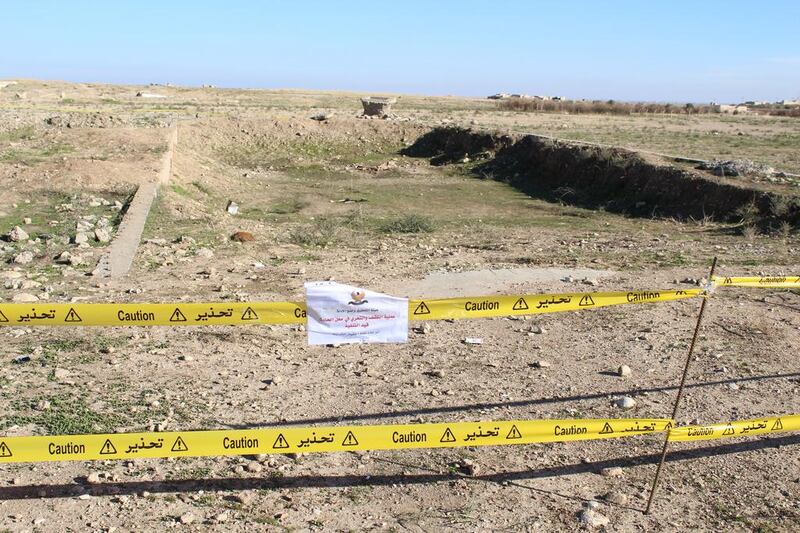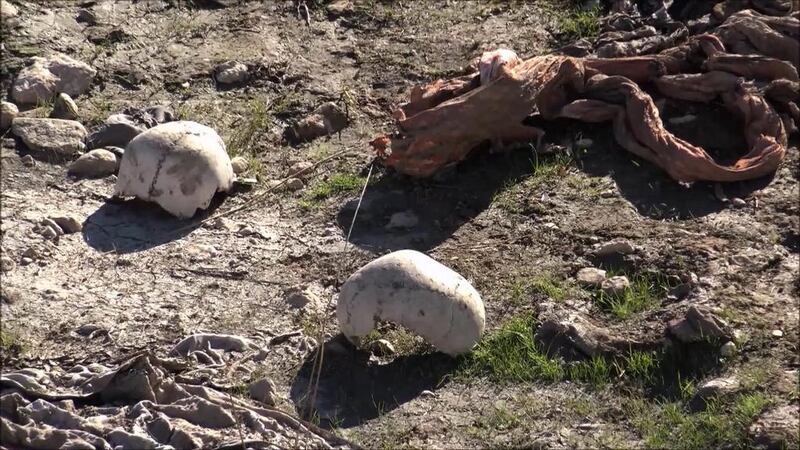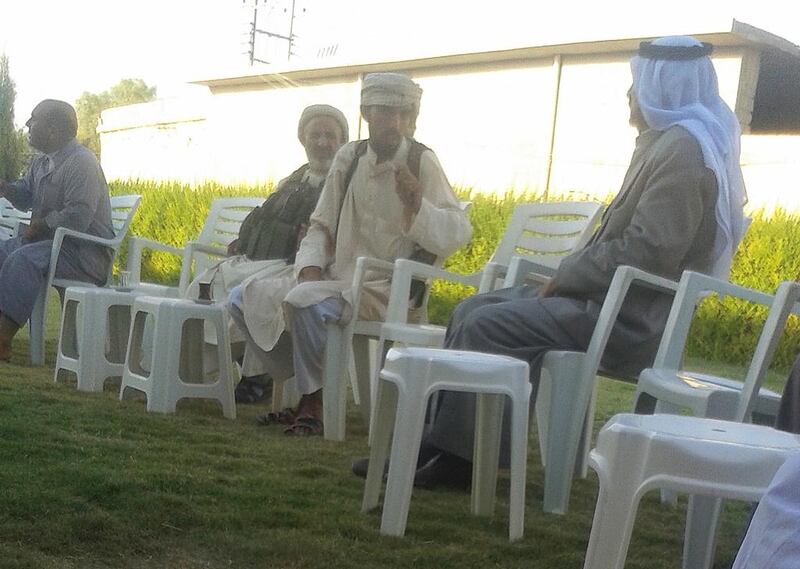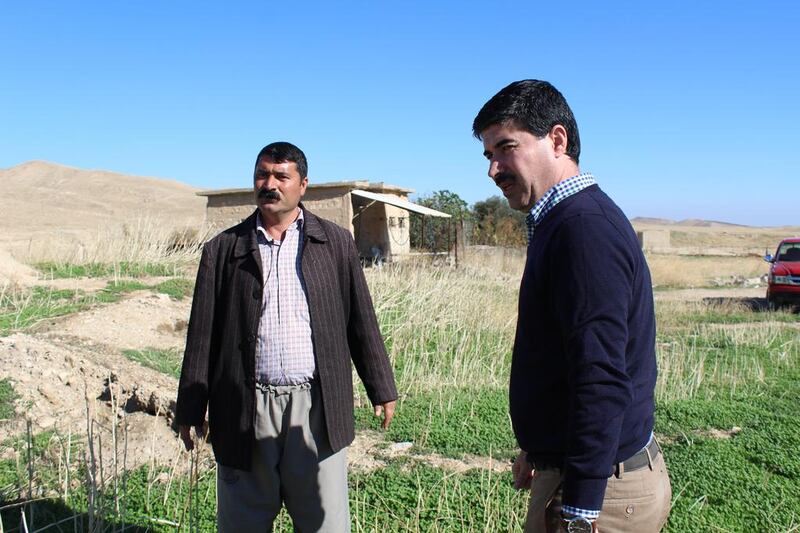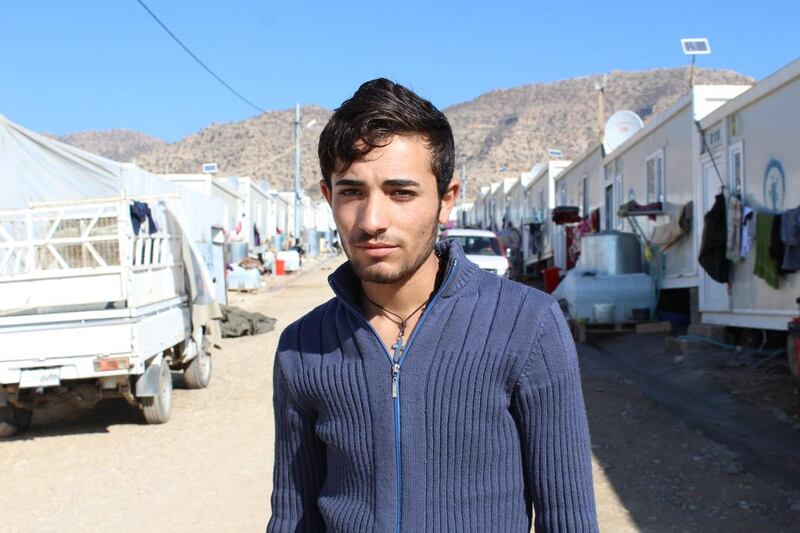SINJAR, Iraq // In the abandoned village of Khani at the foot of Mount Sinjar, a Yazidi man breaks down and cries.
Said Khader Faris is standing next to the spot where his parents, an elderly couple in their eighties, were shot dead by ISIL militants when the group rampaged through the area in August last year.
His family was among a group of Yazidis who fled from a nearby village when ISIL swept in, only to be pursued by the extremists to Khani.
From there, the group tried to escape to the top of Mount Sinjar, but “there were some old people who couldn’t walk far, and the others couldn’t carry them”, Mr Faris says after regaining his composure.
Those left behind were killed by ISIL and their remains now lie under a mound of earth a few feet away — Mr Faris’s parents among them.
Mass graves dot the picturesque plains and gently rolling hills that stretch south from Mount Sinjar, an area where members of Iraq’s minority Yazidi group have lived for centuries. Around 1,300 Yazidis were killed by ISIL here, estimates Hussein Kasim Hassoon, who heads efforts by the Kurdish Regional Government (KRG) to document the extremists’ crimes against the Yazidis.
After ISIL was expelled from the area by Kurdish forces earlier this month, the graves are rapidly being discovered. Some are small, hastily dug by the killers to cover their crimes. Others are larger, and point to a more methodical approach.
In a hollow next to the gutted Sinjar Technical Institute in the village of Solag, just north of Sinjar, human remains lie scattered among tattered scarfs and sullied pieces of clothing. They belong to the old women of Kocho, a village several kilometres away, who were brought to Solag by ISIL to be killed.
Seventy-six bodies are thought to be buried in this hollow and the surrounding soil, the second largest Yazidi mass grave discovered to date.
Throughout the Sinjar area, Yazidis like Mr Faris mourn the murder of loved ones.
When ISIL militants stormed into this remote part of northern Iraq last year, they encountered little resistance, and swiftly took the areas surrounding Mount Sinjar. Tens of thousands of Yazidis scaled the mountain and held out in a desperate defence, but many never made it to the top.
Almost 6,000 were captured, says Mr Hassoon. The women and girls as young as nine were forced into sexual slavery, while the boys were taken from their mothers to be indoctrinated into becoming future militants. The men and old women were killed.
But more than any other village, Kocho bore the brunt of the ISIL onslaught.
According to survivors, only around 200 of the roughly 1,900 inhabitants managed to escape ISIL — the rest are now dead, missing, or abducted.
The grave at the technical institute was discovered after ISIL was pushed out of the town of Sinjar and the surrounding villages — including Solag — on November 13. News quickly spread through the Yazidi community and to the survivors of Kocho, plunging them into despair.
“I saw the mass grave on the day of liberation. I cried and felt helpless, I lost all hope,” says Khader Khadida Khalas, a Yazidi from Kocho who now lives in a refugee camp near the Kurdish city of Dohuk. Mr Khalas has not heard from his mother, his father’s second wife and his four half sisters since last year, and believes them to all be buried in the soil of Solag.
DEADLY DECEIT
The inhabitants of Kocho, the southernmost Yazidi settlement in the Sinjar area, stood little chance of escape when ISIL launched its attack on August 3, 2014. After surrounding the village, the militants persuaded its inhabitants to cease resistance in exchange for guarantees of safety.
The villagers were told they would not be harmed if they paid a religious tax also imposed on Christians by the group, survivors say. But they were deceived. ISIL considers the Yazidis, non-Muslims who practice an ancient faith, as devil worshippers who can be killed and enslaved at will.
ISIL soon threatened to kill the villagers if they refused to convert to Islam, only to appear to backtrack a few days later. Then, on August 15, the militants came to the village in force. They again demanded that the Yazidis convert, but promised they could leave ISIL-held territory unharmed if they declined.
After the villagers refused, they were herded into Kocho’s school, where the men and women were separated, and their valuables taken from them. The men were piled onto the back of trucks and driven off, one group at a time.
The men had been told they would be driven to Mount Sinjar. Instead, the extremists brought the Yazidis to farm houses near the village, where they were forced to climb into empty irrigation ponds and shot. According to Mr Hassoon, 380 men from Kocho perished that day.
The same fate befell the old women, who were trucked to Solag and butchered. After the killings, ISIL came with bulldozers to cover the bodies with earth and flatten the ground, but some of the evidence remains visible.
THE SURVIVORS
Nineteen men survived massacres in at least four different locations, says Ali Abbas Ismael, who managed to escape.
Mr Ismael was hit in the back and the arm when ISIL shot one group of around thirty men, surviving only because others fell on top of him, shielding him from further bullets.
“They shouted ‘Allah Akhbar’ and started shooting. They were filming the massacre,” he says, sitting on the floor of a container in the refugee camp near Dohuk.
Heavily wounded, he and two other men crawled out of empty water ponds now filled with corpses, and saw the militants return with a bulldozer to flatten the grave.
Kheder Hassan Ahmed, a handsome 18-year-old with carefully styled hair and mournful eyes, was among seven survivors of a group of 33 men who were shot by the extremists at one of the farms they had earmarked for murder. Bleeding heavily from a gunshot wound in the neck, he walked all night to reach the mountain.
He does not know what became of his parents and his four brothers, but after the grim discovery at Solag he fears the worst.
“They killed all the old women, and my mother was old, so I think she is dead. Now I don’t have any hope that she is alive, or that my brothers and my father are still alive,” he says.
Mr Khalas, meanwhile, survived a massacre at another farmhouse by pretending to be dead, but saw the militants kill a cousin who lost his nerve and did not keep quiet. After escaping from the mass grave, Mr Khalas patched up his wounds with his socks and scarf. On the way to the mountain, he and other survivors drank cooling water from the engine of a pick-up truck to quench their thirst.
GENOCIDE
Mr Hassoon, an expatriate Yazidi who had worked on genocide cases in Holland, happened to be visiting relatives in Sinjar when ISIL attacked, and was forced to flee to the mountain. On his first day on the plateau, he heard gun salvos ring out from the plains below, and knew that ISIL was shooting civilians en masse.
After ISIL was pushed out of the areas north of the mountain last December, Mr Hassoon found five mass graves. They were discovered quickly as witnesses had already alerted his office about the killings. On the southern plains, five mass graves have already been found and more gruesome finds are sure to follow.
“We only just liberated the city [Sinjar], and around the city there are a lot of villages, where we will find a lot of evidence of genocide. There are still areas under the control of ISIS — we believe that we will discover more there,” says Mr Hassoon, standing next to the Solag grave.
The investigator wants to build a case for genocide that can be taken to the International Criminal Court (ICC) in The Hague, a task that is complicated by the fact that Iraq is not a member of the ICC.
There are other obstacles also. After recording testimony from Mr Faris in Khani, Mr Hassoon drove a few kilometres along the new front line to Solag. The technical institute is located behind the village and now level with new defensive positions established by the Kurds. There is nothing in between the site and ISIL, which holds a village that lies in plain sight of the grave.
As Mr Hassoon speaks, a mortar round fired from enemy territory lands nearby, the explosion sending a plume of smoke to the sky.
But while Solag’s precarious position makes it difficult for forensic teams to gather evidence, it remains impossible to investigate the graves in Kocho, which is still held by ISIL.
THE CAPTIVES
Mr Khalas grieves not only for the dead, but also for his relatives who remain in ISIL captivity. A niece and her daughter are being held as slaves by militants in Anbar, a province in western Iraq. Two more nieces and a young nephew were bought on the ISIL slave markets by a Saudi fighter called Abu Abdullah, who took them to Aleppo in Syria. Before long, the militant sold on the younger niece, twenty-year-old Khola Khadida.
In WhatsApp voice messages sent from Aleppo, the older niece, twenty two year-old Heam, tells Mr Khalas of their sad fate.
“A Libyan women took my son,” she says in one message. Her voice is soft, and she is forced to speak in Arabic so her captor can listen in, rather than her native Kurdish.
“I haven’t heard from my sister,” Heam says in another message, crying.
“Send my regards to my family,” she says in a third recording, and asks about her brother who lives with Mr Khalas in the camp.
In other voice messages, Abu Abdullah taunts Mr Khalas, telling him that he will not accept ransom for Jalal, his thirteen-year-old nephew.
Since the Russians began bombing Aleppo in October, the city is without internet, and even this tenuous link to Heam has been cut.
NO TRUST, NO RETURN
Shot, raped, abducted, and mourning the loss of their kin, the survivors of Kocho say they can never return to their village. Haunted by dark memories, they do not want to be reminded of that terrible day in August last year.
“What am I going to do in an empty house? Its too difficult to go back to that place and feel that pain again,” says Naseh Hadi Hussein, who lost his parents and five siblings.
The Yazidis also mistrust the Arabs and Turkmen Sunnis who lived in the surrounding villages — they accuse them of complicity in the murders. Many of the ISIL killers were tribesmen from the area, able to speak Kurdish to communicate with the Yazidis, says Mr Ahmed.
The ISIL leader who tricked Kocho’s village elder Ahmed Jasso into surrendering was Abu Hamza Al Katoni, a Sunni Arab from a nearby tribe, says Mr Ismael. To prove it, he produces a picture taken on his phone, which shows the two men conversing, sitting on plastic chairs on a lawn. Jasso, who did not survive the massacres, sits upright, while Katoni, a pistol holstered under his arm, leans forward in an aggressive manner.
Mr Khalas says that after the massacre at Solag, a Sunni Arab who frequently visited Kocho, called his cousin. “He said: ‘I killed your wife and your mother, now I will bury them,’” claims Mr Khalas, who did not believe that anyone would be capable of such cruelty when he first heard about the call.
With memories too painful to revisit, and all trust lost in their neighbours, most of Kocho’s survivors just want to leave Iraq. A few want to stay in the Sinjar area, which has been home to the Yazidis for countless generations. Wherever they end up, the past will stay with them.
“I won’t be able to forget this for as long as I live. This hurt will be with us forever,” says Mr Ismael.
foreign.desk@thenational.ae
